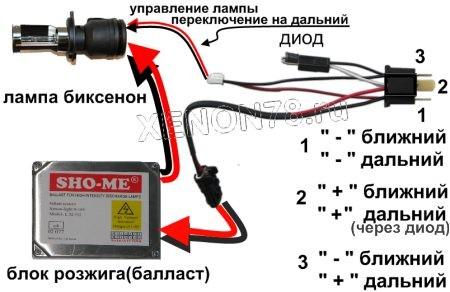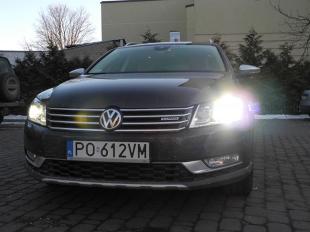
Xenon and bi-xenon - installation and repair. Guide
Content
 Xenon or bi-xenon headlights are an increasingly common vehicle accessory. How do they work, what are their advantages and disadvantages, and what should I do to install xenon on a car that does not have them?
Xenon or bi-xenon headlights are an increasingly common vehicle accessory. How do they work, what are their advantages and disadvantages, and what should I do to install xenon on a car that does not have them?

A xenon lamp produces about 3200 lumens at 35W, while a halogen lamp produces 1500lm at 55W. In addition, a xenon lamp is much more durable than a halogen lamp, comparable to the life of a car.
Initially, xenon headlights were very expensive and therefore were installed - most often optionally - on cars of a higher class. Currently, such devices are cheaper and can be ordered even for city-class cars. They are also installed by many used car users.
Some rules - installation of xenon only by agreement
However, the installation of xenon lamps is not just a headlight replacement. Xenons must meet certain conditions in order to be used.
In accordance with UNECE Regulation 48, also in force in Poland, dipped-beam headlamps of motor vehicles moving on public roads with a light source with a luminous flux of more than 2000 lm, such as xenon headlights, must be equipped with headlight cleaning devices. approved in accordance with UNECE Regulation 45. In addition, xenon headlights must be equipped with an automatic leveling system.
In addition, each lamp is approved for the use of this type of bulb, and when replaced with another, it loses this approval. Xenon kits are approved for a specific car model. Do not use headlight washers and xenon self-levelling systems.
Installation of xenon kits without the above equipment may result in the fact that the registration certificate will remain at the diagnostic station during a periodic inspection or in the event of a police check. This is also a threat, because such xenons will blind other drivers.
Xenon headlights - low beam only
The main distinguishing feature of xenon lamps is the color of the light beam - it is intense snow-white. But in order for the lamps to light up, you need a whole set of devices. The main elements of the xenon headlight system are the current converter, the igniter and the xenon burner. The purpose of the converter is to generate a voltage of several thousand volts and supply an alternating current of approximately 85 amperes.
The burner has electrodes surrounded by a gas mixture, mainly xenon. Lighting causes an electrical discharge between the electrodes in the bulb.
See also: Decorative car lighting - what is fashionable and what are the rules for it
The actuating element is a filament surrounded by halogen, the task of which is to combine the evaporated tungsten particles from the filament. The fact is that the evaporating tungsten should not settle on the glass covering the filament, which can lead to its blackening.
The main thing is that xenon lamps work only for dipped beam. Conventional halogen lamps light up when the driver switches to high beam.
Bi-xenon headlights - low and high beam
In modern high-end cars, bi-xenon lighting is common, i.e. both low beam and high beam use xenon technology.
In practice, due to the need to quickly turn on the high beam headlights, this is done by a single burner that lights up along with the low beam headlights, and the high beam headlights are turned on by replacing the optical assembly inside the headlight, for example by replacing the shutter or moving the cutter.
However, there are already xenon burners equipped with a special electromagnet that drives a tube with a luminous gas bubble. When the low beam is turned on, it is further from the reflector and the light is scattered, and when the high beam is turned on, the tube moves into the burner, changing the focal length (focusing the light more).
Thanks to the bi-xenon headlights, the driver has much better visibility, both when operating as low beam and high beam (long beam range).
ADVERTISING
Xenon kits for installation outside the factory
Xenon lamps can also be installed in vehicles that were not equipped with them at the factory. Of course, it is not enough to replace the bulbs themselves. A complete kit consisting of filament, converter, wiring, auto-levelling actuator and headlight washer must be installed. It must be a kit approved for this vehicle model.
See also: How to safely buy a battery online? Guide
Meanwhile, in trade, especially on the Internet, there are mainly sets consisting only of converters, light bulbs and cables. Filaments without an alignment system will not shine in the direction they should, if the headlights are dirty, it will shine worse than in the case of classic halogens.
A car with xenon lamps without auto-corrector and washers may not pass inspection. The driver of such a vehicle may also have problems in the event of a roadside inspection.
However, as we found out in several stores selling xenon kits, such an assortment is still bought, although individual elements are the most popular, for example, the filaments themselves or the converters themselves. This is due to the fact that such parts are purchased as spare parts for failed components. But some drivers still install incomplete kits for PLN 200-500, risking verification problems and additional costs.
Xenon and bi-xenon - how much does it cost?
When considering the cost of installing xenon or bi-xenon, a complete kit must be considered, i.e. with self-levelling system and sprinklers, as well as filaments, an inverter and small accessories.
Prices for such a kit, including assembly, start from PLN 1000-1500 and can reach PLN 3000. So this is a cost comparable to equipping a new car with xenon headlights at the stage of ordering from a dealer.
Advantages and disadvantages of xenon
The main advantage of xenon lamps has already been replaced - it is better illumination of the road and a greater range of light. The durability of the threads is also important, reaching 200 XNUMX. km of the vehicle.
In addition, the filament itself consumes much less electricity than a conventional light bulb, which contributes to lower fuel consumption (the generator is less loaded).
Finally, the filament does not heat up as much as a conventional halogen lamp, which means that the headlight glass does not deform.
See also: Daytime running lights - halogen, LED or xenon? – guide
However, the main disadvantage of xenon is the high cost of the service. The thread itself costs an average of 150-200 zł. And since they need to be replaced in pairs, in case of damage to such an element, we will spend at least PLN 300.
The fact that the filaments have a long life is comforting, but if someone buys a used car with a range of several hundred thousand kilometers, equipped with xenon, the failure of the filaments is very likely.
In cars with high mileage, reflectors can also become loose (the beam of light vibrates while driving) or even dim.
Some point out as a disadvantage of xenon that when the light is turned on, the filament glows at full brightness after 2-3 seconds.
According to the expert
Piotr Gladysh, xenony.pl from Konikovo near Koszalin:
– Xenon and bi-xenon headlights certainly improve the driver's field of vision and thus contribute to increased road safety. The problem, however, is that many drivers assemble kits themselves, which they buy from random places. Later, a beam of light, instead of illuminating the road, blinds oncoming drivers. Two or three years ago, cheap Chinese kits that did not meet any technical standards were popular. We also face the situation of someone buying a high mileage, xenon-equipped used car for relatively little money. And then he cannot afford to service these xenons, because he did not expect that one filament could cost several hundred zlotys.
Wojciech Frölichowski
